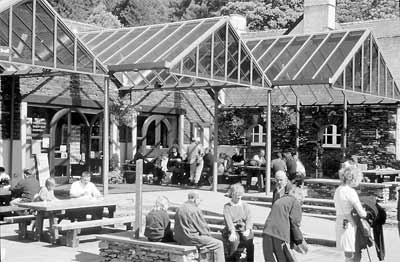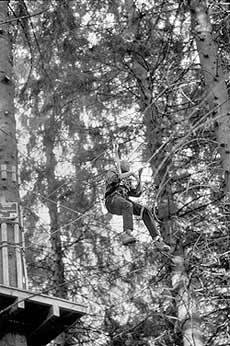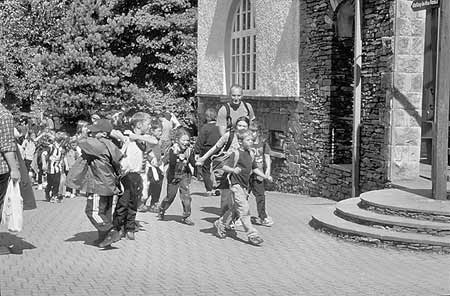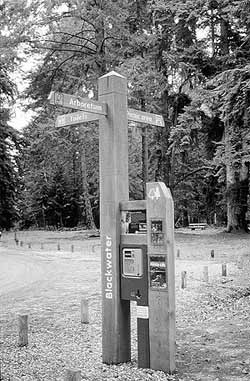


R. Leslie
Rod Leslie is Environment Manager, Forest Enterprise England (a government-owned executive agency which manages State-owned forests), Bristol, United Kingdom.
In England, the Forestry Commission has successfully introduced charges to generate revenue for maintaining recreation resources.
In the 1990s, the Forestry Commission, the government-owned forest department of Great Britain, reviewed the recreation infrastructure in England and realized that it could not maintain recreation resources and meet the needs of visitors unless it generated new revenues. It decided to support recreation by generating extra income through the development of the services visitors wanted. The objective was not simply to make a profit, but also:
Between 1992 and 2000 the proportion of the Forestry Commission’s recreation costs covered by income rose from 34 to 50 percent. All running-cost revenue (as opposed to capital) needs are covered except staff salaries and some fixed costs. Visitor centres cover all their cash costs.
Forest visitor centres based around viable businesses including shops, restaurants and cycle hire cover their costs – and generate jobs and income to the rural economy |
 |
R. LESLIE |
In Western Europe, England is second only to the Netherlands in population density. The extensive, populous agricultural lowlands of central, southern and eastern England are ringed by the uplands of northern England, Wales and Scotland. Scotland and Wales are much less densely populated.
The United Kingdom was one of the world’s first industrial nations, and this is reflected in today’s demography: over 90 percent of the population earns a living in towns and cities, and less than 1.5 percent works in agriculture and forestry. In the nineteenth century the country was the world’s leading manufacturing economy. Today, however, services comprise over 80 percent of the economy.
It is increasingly difficult to make a living from primary production of food or timber. Accordingly, England has shifted its forest management focus from an emphasis on the single purpose of timber production which had prevailed during the industrial era to management for multiple purposes. This change of direction, confirmed by the England Forestry Strategy in 1999, has been reinforced by falling timber prices and the development of new areas of activity including regeneration of land damaged by industry.
As disposable wealth increases, spending on leisure is a big growth area. However, the election of a Conservative government in the United Kingdom in 1979 ended the heavy public-sector investment in countryside recreation of the previous 20 years. This change coincided with a broad worldwide shift towards market economics, and was mirrored in many other developed countries.
These trends have played an important part in the Forestry Commission’s development of recreation services over the past decade.
The Forestry Commission, established in 1919, is now Great Britain’s largest land manager, with over 1 million hectares, of which 260 000 ha are in England. This area accounts for 19 percent of England’s woodlands and 2 percent of its total land area.
Historically, the Forestry Commission has been a leader in countryside recreation in Great Britain. It launched the nation’s first Forest Park in Argyll in 1936. Forest Parks are large State-owned forests in popular recreation areas. National Parks – a mix of private and State land and semi-natural and farmed or forested habitats – were developed later, after the Second World War. Both are cultural rather than natural landscapes.
The Forestry Commission has a “freedom to roam” access policy that is unique in the British countryside; its distinctive sign system has become synonymous with open public access.
The Forestry Commission began to develop its recreation infrastructure in the 1960s. It was inspired by the pioneering work of the United States Department of Agriculture’s Forest Service, and it established new design standards for sensitive recreation development in the British countryside, using professional landscape design expertise. Central to the infrastructure were car parks linked to marked forest trails, and in some places toilets and visitor centres. In the spirit of the times, their use was generally free; charging was seen as conflicting with the provision of a public service.
The commission also developed campsites and forest cabins – high-quality wooden chalets in secluded forest areas – as a business. These have always been managed as a separate entity and are among the Forestry Commission’s most successful ventures, making a return on capital of up to 15 percent. However, the number of cabin sites has been limited by the availability of capital. Various public and private partnerships have been and are being explored to develop this service.
The Forestry Commission has become increasingly responsive to its visitors and communities. An advantage of offering services for sale is that sales provide hard evidence of the attractiveness of the product. However, the commission also employs many other methods to canvas opinions and involve people. It uses generic national opinion surveys and its own specialist site surveys and consults widely on its multipurpose forest design plans, giving people the opportunity to participate in recreation provision and shaping the forest environment. The extent of consultation is determined by the scale of change; where a major development is planned, a forum bringing together major stakeholders may be established, followed by wider community engagement through publications, meetings and drop-in days at community centres.
Car parking. Parking fees are now charged at sites that have additional facilities such as visitor centres, toilets, play trails or sculpture trails and that attract a large number of visitors, require staff on-site and are expensive to maintain. Ticket machines are generally used, but gate staff are employed to collect fees at peak times on the busiest sites. Charges are benchmarked locally, typically based on a proportion of the charges at town centre car parks.
For pragmatic reasons parking is not charged at smaller, more remote sites, where the cost of ticket machines or attendants would not be worthwhile. In remote sites with few visitors, security, mostly vandalism and theft, is a problem.
Entry fees. A fee for entry on foot is only charged at two sites, the National Arboreta at Westonbirt and Bedgebury. These are more formal attractions, comparable to stately homes where charging for access is standard practice. Again, prices are benchmarked against comparable local attractions.
Retail. National household surveys indicated that visitors welcomed catering and retail but were not interested in the expensive museum-style displays at the core of traditional visitor centres. The commission initially worried about how visitors would react to a new, consumer-based approach, but the overwhelming response has been positive.
The shops started as information points, distributing or selling books and leaflets linked to exhibits. Surveys showed that visitors prefer to obtain information from people rather than to read written texts or computer screens, and increasing income through the sale of a wider range of goods has been essential to maintaining a staff presence on-site.
The trend towards retail is part of the broader emergence of consumption as recreation. For many visitors, facilities such as shops and cafes have become a reason to visit in their own right. The shops sell gifts, including local produce, functional goods such as clothing, and souvenirs, from postcards to calendars, framed photos and videos. The range of goods has been built up through a combination of intuition and calculation, using professional sales methods for stock management and procurement.
There has also been a trend towards higher-priced items. Originally few goods were priced at over €20. Now the finest handmade wood products may sell for €200. Initially the largest shop, at Westonbirt Arboretum, turned over €125 000 per annum. Today the figure is €500 000, and a garden centre has been added which generates another €500 000 on the same site.
The proportion of income coming from direct charges is decreasing as on-site sales of goods and services increase.
Catering. Surveys showed that refreshments are important to forest visitors. Restaurants are now the heart of the major centres. While traditional exhibits can be repetitive for local visitors, a good cafe can be a reason for frequent return visits. Catering has a high labour input, leading to the creation of new jobs which are important to fragile rural economies.
Events and services. Events programmes have developed beyond expectations. They range from ranger-led walks for a few enthusiasts to a €1.4 million concert programme enjoyed by over 40 000 people. Big events such as festivals of wood, gardening and wildlife reward the necessary effort by bringing in money, but the biggest payoff is the visitors’ enjoyment of their national forests in new ways. Visitors can watch an osprey at its nest through a television camera or follow the passage of bats through the night forest with a wildlife ranger. This provision is a growth area in a wealthy society where people are happy to pay for a quality experience.
Education. “Earth education” programmes are popular with teachers and children, and are designed around national school curricula. They communicate complex environmental concepts through game-based activities.
Market research showed that the big cost for schools is transport to get to the forest, and that once they are there a small charge for the facility is not significant. The quality of the visit is the most important issue.
Although the subsidy to the education service in recreation areas has remained the same, charging and better business management have made it possible to expand the education service for the same overall cost, so that the number of children who benefit has more than doubled.
The greatest successes have come through innovation: new activities that excite visitors and are outside their normal experience. The Forestry Commission seeks to identify and capture new trends. The following are some examples.
Sculpture in the forest. At Grizedale in the Lake District and in the Forest of Dean, unique trails with sculptures commissioned for the specific sites have had a public response beyond expectation.
Play trails. Children (and adults) love the trails with fantasy wooden sculptures inviting them to crawl through the snake pit, cross the crocodile swamp, climb Charlotte the spider’s web and swing and climb on snakes and ladders. The trails help children develop physical skills and confidence in a safe environment. Parents appreciate the calm, relaxed forest environment.
Cycling. The 1990s brought a strong interest in fitness and the countryside. Mountain biking boomed, and the Forestry Commission became the leader, developing opportunities ranging from family cycling to single-track mountain bike trails and downhill racing. Again, the Forestry Commission – in partnership with rural development agencies that recognized the economic contribution of this specialized countryside tourism – followed its philosophy of excellence to develop facilities that meet international standards, drawing on experience from the United States.
High-level rope courses. The idea of rope courses built high in mature trees was imported from France in 2002. The courses consist of rope bridges and a range of obstacles up to 15 m above the ground linking trees. Wire rope slides bring participants back to the ground after each obstacle. Participants wear a sophisticated harness that ensures they are always clipped to a safety wire, providing total safety. The public’s reaction has surpassed expectations. Participants are terrified, exhilarated or both – which can be a profound experience for people whose daily lives are thrill-free. The courses are a successful business and have become an important local employer.
Up to 15 m off the ground, the “Go-Ape” high-level rope course includes rope bridges and wire slides, providing a thrill in complete safety |
 |
R. LESLIE |
Charging for school visits helps the government subsidy to the education programme go further – but charges are waived for groups that cannot afford to pay |
 |
R. LESLIE |
The commission recognized from the start that there are issues of fairness and equity in charging for services on the national forest estate. Taxpayers have already paid to develop the services, so why should they have to pay to use them?
The main direct charge is for car parking. The assumption was that car owners generally accept the practice of charging for parking and that car ownership itself implies an ability to pay an appropriate fee. That charging for car parking has become almost universal in England over the past decade has been a significant factor in this acceptance. There is no charge for entry to the forest or for facilities such as toilets or visitor centres. The preservation of free access on foot is the key principle. While many forests are only readily accessible by car, there is generally a free car park within 1 to 2 km of the paid car park, so visitors do have the option of free parking.
There has been very little resistance to paying for services. Visitors on holiday expect to pay for their enjoyment, and the cost is generally accepted as value for money. Some concern has come from local people; frequent local visitors may resent having to start paying for something they (rightly) regard as “theirs” already. Therefore a very cheap annual ticket is always available for frequent users. Priced at the equivalent of 10 to 15 visits, this is almost universally seen as a good deal.
Staff are authorized to waive charges – for example, for educational visits – for identified user groups that are likely to be discouraged by the cost, including economically or physically disadvantaged groups.
Income reflects changing visitor behaviour: at current charge levels there is no evidence that charging per se has caused a decline in visitor numbers. There has been, however, a gradual decline at traditional attractions visited in touring by car, for example the Symonds Yat viewpoint in the Forest of Dean, and at sites that have not changed or improved for many years. In contrast, there has been a dramatic increase in visits linked to more active, participative recreation including cycling and play trails. Moors Valley country park, site of the first big play trail, went from modest local use to 800 000 visits per annum after this product was introduced.
New products can bring new environmental impacts. However, making more money doesn’t necessarily mean more impacts – a common false assumption. The challenge in the most heavily used areas, such as the New Forest, is to increase spending per head – for example, by persuading more people to stay overnight – and to benefit the local economy without increasing visitor numbers. Centres where there are more activities, for example Grizedale in the Lake District, may reduce traffic movement by keeping visitors occupied all day. “Honey pot” attractions, such as good facilities or natural (e.g. a view or waterfall) or non-natural (e.g. an arts trail) features, are used as a positive tool to direct impacts to robust or lower-value sites such as robust pine forests, and away from more fragile semi-natural lowland heath.
About ten years ago the Forestry Commission decided to rationalize the recreation infrastructure, discarding the mediocre and concentrating resources where they would give visitors the most benefit. The need to do this was not seen as a failure; public attitudes and preferences change, and managers should expect to revisit the services offered on a 10- to 20-year cycle.
The commission opted to close facilities that had never attracted significant numbers of visitors. In addition, toilets at local-use sites were closed, since short-term visitors from nearby did not actually need them, and the toilets were also a focus for antisocial behaviour. Furthermore, complexes of short, medium and long trails, routinely established in the 1970s, were reduced to single paths. The complexes did not meet the needs of most visitors, the marking confused visitors, and maintenance was high. In addition, the commission concluded that marking trails in local woods was a waste of resources, since local people were already familiar with the woods.
There has been little negative reaction, reflecting the low value attached to these facilities. In two instances where there were significant objections, the facilities were replaced.
At the same time, a number of improvements have been made. Instead of aiming at the hypothetical “average” visitor as in the past, the Forestry Commission now recognizes the diversity of forest users and uses, distinguishing for example between visitors making short visits to woods near their homes and holiday visitors to remoter forests such as those in the Lake District.
Since 2002, in partnership with development agencies which have provided urban regeneration funding, the Forestry Commission has established over 40 km of new all-ability trails in woods close to centres of population. These are high-quality trails with flat gradients and an even surface, suitable for wheelchairs, pushchairs and the less mobile.
High-quality trails for family cycling have been developed in recent years and are very popular. These trails are usually a mix of forest timber roads, with a finer surface if necessary, and purpose-built trail sections.
Large centres with many visitors and the potential to offset costs through income have been expanded. More visitors and more activity make centres more viable. Although small, local-use sites had little prospect of making money, rather than close them all, the Forestry Commission mandated local managers to find innovative means of making them viable.
Where money has been available, the core infrastructure has been expanded, in particular car parks and toilets. While these require considerable capital investment and are costly to run, they are fundamental to the generation of cash by shops, cafes and activities.
It is always tempting to buy more with limited funds. But extensive low-quality facilities require more overall maintenance than targeted quality development. Good design and maintenance are increasingly important, since the legal responsibility for safety is on the landowner, and claims and litigation in general are becoming more frequent.
Outdoor furniture and sign structures have been redesigned by landscape architects for a contemporary look and lower maintenance. Chunkily built from Forest Stewardship Council (FSC) certified timber from Forestry Commission forests, they look good in the forest environment and are resistant to vandalism.
The Forestry Commission has become more relaxed about the respective roles of public and private businesses and often works in partnership with private companies; a mix of public and private provision has evolved, with no fixed rules. In some places the catering and shops are run by the commission, while in others one or more may be franchised. Businesses such as cycle hire or rope courses are generally private, while play facilities are run by the commission. The main concern is to maintain a reputation for high quality.
Forest recreation and the wider economy The Forestry Commission’s policy is that economically the forests and recreation centres in rural areas are there to benefit the wider rural economy, and it is the rural communities (not the visitors) that are the target for public funding. Local communities benefit if visitors use overnight accommodations and buy food and local goods. Recreation services generate sustainable business in areas that are economically fragile and otherwise a target for government support. The closure of Britain’s countryside for several months during the 2001 foot-and- mouth disease epidemic brought home the importance to the wider rural economy of recreation in the National Forests. For example, closure of the Forest of Dean – where tourism generates p55 million each year in the broader economy, while timber income is only p1.5 million – resulted in a 70 percent drop in local tourism over the Easter holiday, even though other attractions and accommodations were open. In Wales, the Coed Y Brenin mountain bike centre has drawn an estimated p7 million of tourism income per year into a remote and economically fragile rural area. The Welsh Assembly Government has now given the Forestry Commission p1.2 million to set up further centres. The commission expects to attract p20 million per year of extra business to the Welsh countryside. |
The revenue generated from charging has revolutionized operations, making it possible to enlarge staff, improve infrastructure and expand services. However, revenue is rarely sufficient for major capital expenditure, which is a problem as many of the centres are too old or too small to realize their potential and need to be completely overhauled.
One of the keys to the current growth is funding through partnership with other agencies, often as part of a broader rural development approach. The ability of the Forestry Commission to improve the quality of life in some of the country’s poorest areas makes it an attractive partner for funding agencies. Key public and semi-public sources include proceeds from United Kingdom’s National Lottery, regional development funding from the central government and development funding from European structural funds. In this way, the Whinlatter centre, which in 2002 attracted 100 000 visitors to see England’s first breeding ospreys, is being refurbished and modernized with total project grants approaching k1.5 million. An economic analysis predicted that this investment will provide a benefit to the local economy of k2 million each year. Arts, cycling, education and all-ability access each attract funding from a range of sources.
A car-park meter combined with an information point, chunkily built from wood to look good in the forest and resist damage |
 |
R. LESLIE |
The Forestry Commission’s initial concerns that a commercial approach would harm the forest environment were unfounded. For forest visitors, the level, quality and diversity of activities and services have increased while core government funding has fallen. Facilities are in better condition than they were ten years ago, and the business has a new culture of innovation, quality and customer focus. Previous visitors return, and new customers are attracted.
There have been some missed opportunities. For a long time the Forestry Commission thought that each site should be unique and thus failed to benefit from economies of scope and scale. Some successful products such as play trails were not rolled out fast enough. Some big events and some centres did not have immediate success.
The main defence against failure has been flexibility. Local managers have a strong mandate, and the commission thinks carefully about how long to persist with ideas that do not seem to be working.
Much of this experience may be familiar to some, but there are many public recreation facilities in the United Kingdom, Europe and North America that could benefit from these lessons. Operating environments will vary: there is no future in trying to charge for car parking if it is not an established convention in the area. However, the greatest barrier seems to be the inability of public institutions, accustomed to the expectation of public funding, to react to the loss of government money. The Forestry Commission has been surprised by the extent to which changes introduced through necessity have increased the quality of service and enjoyment of visitors while helping to finance recreation provision.